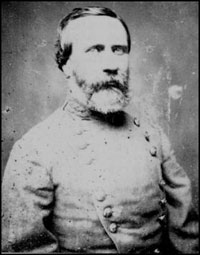
Richard Heron Anderson (1821-1879)
Richard Heron Anderson (October 7, 1821 - June 26, 1879) was a career U.S. Army officer and a Confederate general in the American Civil War.
Richard "Fighting Dick" Anderson was born in "Hill Crest", near Stateburg, South Carolina. He graduated from the U.S. Military Academy in 1842 and was commissioned a second lieutenant in the 1st U.S. Dragoons (heavy cavalry). He served in the Mexican War and was brevetted to first lieutenant for gallant conduct at San Augustin.
On March 3, 1861, Anderson resigned from the U.S. Army and accepted a commission of colonel with the 1st South Carolina Infantry regiment. He was given command of the Charleston harbor area after the capture of Fort Sumter.
He was promoted to brigadier general on July 19 and transferred to Pensacola, Florida, where he was wounded in the arm during the Battle of Santa Rosa Island.
He joined the (confederate) Army of the Potomac in February, 1862, which was absorbed into the Army of Northern Virginia later in the spring, as a brigade commander. In the Peninsula Campaign, he distinguished himself at Williamsburg, Seven Pines, and in the Seven Days Battles. At Glendale, he took temporary command of James Longstreet's division. Due to his excellent performance on the Peninsula, he was promoted to major general on July 14, 1862, and given command of the 2nd Division of Longstreet's corps.
At the Second Battle of Bull Run, Anderson launched an attack that broke the Union lines and sent it retreating back to Washington, D.C.
At Antietam, he was in overall command at the sunken road, or "Bloody Lane", in the center of the Confederate defense. He was wounded in the thigh and left the battle, causing his division to falter and eventually succumb to Union flank attacks that routed them from their position.
At Fredericksburg, his division was not heavily engaged.
At Chancellorsville, operating away from Longstreet's command (because Longstreet was on detached duty near Norfolk, Virginia at the time), Anderson pressed the Union left while Thomas J. "Stonewall" Jackson attacked the right. He and Lafayette McLaws left the main battle line on May 3, 1863, and struck east to check the advance of the Union VI Corps (John Sedgwick) into Robert E. Lee's rear. Following the death of Jackson, Lee reorganized his army into three corps. Anderson was admired enough by Lee to be considered for corps command, but instead he was assigned to the new Third Corps commanded by A.P. Hill.
At the Battle of Gettysburg, Anderson's division was third in line of march approaching the town from the west on July 1, 1863, so they arrived late and had little involvement in the start of the battle. (Lee had ordered Anderson into bivouac to rest up for the next day, which could be considered a tactical error on his part. If Anderson had been ordered to attack Cemetery Hill from the west, and if Lee could have moved Richard S. Ewell to the do the same from the north, the Union lines might have broken and the battle—even the war—might have been won.) On the second day of battle, Anderson's division attacked near the Union center, following on from attacks by Longstreet (the divisions of John B. Hood and McLaws) to his right. Anderson's right was successful attacking Andrew A. Humphreys's III Corps division along the Emmitsburg Road. His center, under Ambrose R. Wright, penetrated the lightly defended Cemetery Ridge, making better progress than Pickett's Charge would make the following day. However, his left did not keep up the momentum that was needed. Carnot Posey moved haltingly and William Mahone didn't move from Seminary Ridge at all. Union reinforcements rushed to counter Wright and he was repulsed. Anderson was criticized for his command during this day of battle. He had little effective control of his brigades and his plan to attack all his brigades in line, without a reserve to capitalize on success, was not well conceived. On July 3, Anderson's brigades under Cadmus M. Wilcox and David Lang participated in the waning minutes of Pickett's Charge, but both were driven back.
Next spring, in the Battle of the Wilderness, Longstreet was wounded and Anderson took command of the First Corps, leading it through the Overland Campaign. He was promoted to lieutenant general on May 31, 1864. When Longstreet returned from his convalescence in October, Anderson led the newly created Fourth Corps through the Siege of Petersburg and the retreat to Appomattox Court House and surrender in April, 1865.
After the war, Fighting Dick Anderson was a state phosphate agent in South Carolina.
He died in Beaufort and is buried there in the St. Helena Episcopal Churchyard.